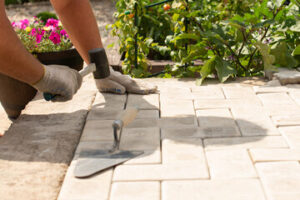Patio Construction can add value and functionality to your home. It can also be a fun project for the family.

Once the area is marked, builders will dig a little larger than the footprint to account for the base. They will then spread and tamp the gravel. A layer of paver sand is then added. Visit https://www.cleanstoneconstruction.com/ to learn more.
When building a patio, it’s important to consider the location. A poorly located patio can interfere with the ease of access to your home or other areas of your yard. It can also cause problems with landscaping or retaining walls, as well as impact the structural integrity of your home.
To prevent such issues, it’s best to build your patio away from the house or other structures. This will help to eliminate any potential obstacles or difficulties during construction and provide you with a comfortable, relaxing area. It’s also important to make sure that your patio is positioned in a way that allows for easy movement between seating areas, if applicable.
The choice of materials can also impact the patio’s final appearance. Concrete is versatile and cost-effective, while pavers are available in a wide range of colors and shapes for a unique look. Natural stone offers a premium aesthetic, but is more expensive and requires more maintenance.
Depending on your local jurisdiction, you may need to obtain a permit before beginning construction on your patio. The permitting process can add time to the overall project timeline, so it’s a good idea to factor this into your planning process.
In addition to permits, your contractor may need to prepare the site prior to construction. This can include excavating and grading the area, as well as installing necessary drainage features. This can be a lengthy process, so it’s best to take this into account when planning your patio construction timeline.
When choosing a patio contractor, it’s important to look for experience and expertise. A reputable contractor will have a portfolio of past projects and references you can contact. They should also be licensed to operate in your area and carry liability insurance and workers’ compensation coverage. Additionally, they should have extensive knowledge of building codes and local climate conditions that could impact the project. They should be able to provide you with a warranty on their work, as well. Landscape Architecture is a Unilock Authorized Contractor and offers a 5-year workmanship warranty on all hardscapes.
Materials
The material you choose to construct your patio will have a significant impact on its appearance and functionality. It’s an important decision that must be made with care, as your patio will set the tone for all other landscaping features in the area – including garden walls, fences and gates.
Stone is a popular choice for patio construction. It’s durable and attractive, with a variety of color and texture options. It also ages well, gaining an appealing patina that can enhance the beauty of your landscape. However, it can be expensive, and its rough surface can make for a bumpy walking area.
Brick is another classic patio construction option. It has a timeless look that complements a wide range of architectural styles, from modern to traditional. Brick is available in a wide range of colors, and can be used to create a unique pattern. Reclaimed brick is an eco-friendly alternative that offers a similar aesthetic at a more affordable price point. Brick is easy to work with, and does not require mortar, which can save money and time during the construction process.
Concrete is an incredibly versatile material, and it can be used to construct a custom-shaped patio. It can be colored, and its aesthetic can be elevated with the use of stamps – which can mimic the appearance of stone or brick, for example. Stamped concrete is made by pressing flexible polyurethane stamps into freshly poured concrete.
Aside from its versatility, concrete is relatively inexpensive. It is an excellent choice if you want to create a durable, long-lasting patio that won’t break your budget. It’s important to keep in mind that concrete can crack over time, and it’s susceptible to moisture damage.
Loose materials such as pea gravel are gaining popularity as an alternative to more traditional, rigid patio surfaces. They offer a more organic, earthy look, and can be mixed with other materials for visual interest. They are also water-wise, as they allow rainwater to soak through the ground rather than run off rapidly over paved areas and into rivers or streams where it may pick up pollutants.
Design
A patio can be a great place to spend time with your family, whether it’s relaxing in the sun or enjoying dinner and drinks in the evening. It can also be the perfect location for an outdoor kitchen or fire pit. Before construction begins it is important to consider how you and your family will use the patio. This will help guide the layout and determine what features you should include in your design. It is also a good time to talk about any obstacles or difficulties that may arise during the project, such as drainage issues. Poor drainage can cause problems that impact the entire yard, including the foundation of your home. It is important to address these issues in the design stage of the project and ensure they are properly addressed during the construction process.
A dry laid patio is built using pavers, bricks or flagstones. Builders follow the same marking, excavation, tamping and leveling methods as they would for a concrete patio. A layer of gravel is placed down and tamped to create a base for the surface material. This is followed by a layer of paver sand that is spread to a thickness no thicker than an inch. This layer is then screeded to create a smooth surface. A layer of sand or fixing material is then brushed over the surface and watered in to lock-in the stones. Once the surface is set the builders can begin laying the individual pavers in the pattern they agreed upon during the design process.
Patios can be built to suit almost any style or taste. Some are designed with a particular theme in mind, such as a geometric or naturalistic look. They can be constructed with a specific color scheme in mind, or they can even be made to resemble an exotic surface such as cobblestone, brick or flagstone.
Having a well-designed and durable patio is one of the best investments you can make in your home. However, like any other outdoor surface, it needs to be maintained. Patios are susceptible to weather damage, cracking and staining over time. Keeping up with regular maintenance is the best way to protect your investment and extend the life of your patio.
Installation
Patios convert outdoor space into living space, making homes more appealing to prospective buyers and increasing their value. Adding this extra living space may also speed up the time it takes to sell a property.
Before any construction begins, the landscaper or patio builder will need to survey the area. This includes examining the soil and looking for any obstacles like trees, plants or rocks that need to be moved before the patio can be built. It’s important to remove any obstructions that are in the way of a new patio as they can cause problems once it is installed.
Once the builders have surveyed the site, they will mark the outline of the patio with stakes and string. This is done to show the size and shape of the patio to help make sure it fits correctly once it’s finished. For poured concrete patios, builders will dig down to the desired depth and then use wood or plastic forms to hold the concrete in place while it cures. For dry-laid paving stones or brick patios, there is no need for forms since these types of materials can be laid without concrete in between them.
The next step is to install a layer of crushed gravel (also known as crusher run or processed gravel). This material will form the base for your patio and it’s essential that it’s level and compacted. It can be tested by driving a metal spike into it with a 3 pound sledgehammer. A spike that holds firm indicates the gravel has been tamped down and compacted properly.
Once this is done, the builders will add a layer of builder’s sand on top. It is recommended that this material be lightly wetted with a garden hose before being used and that it be spread to a depth of 1 inch. Once this is done, it should be tamped down again using a plate compactor.
It is also important that the sand slope away from your house at a rate of about a quarter of an inch per foot. This is necessary to prevent water from running into your home. If you are building a patio that is close to your house, then it’s a good idea to put in some type of edging to protect the foundation from water damage.


